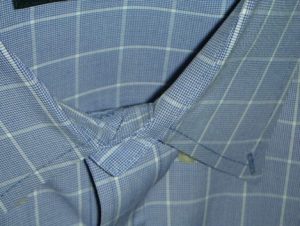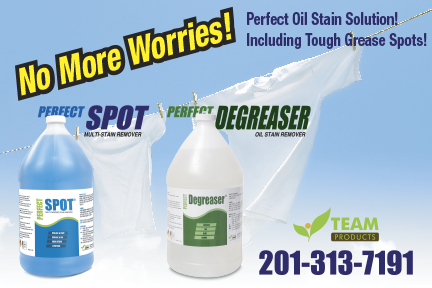There are dozens, perhaps a hundred or more types of products that will enhance your finished product. You probably use many of them yourself. Coat retainers, garment covers, sweater bags, plastic butterflies for shirts, cuff clips, cuff links, bust forms, shoulder guards & tissue paper are just a few examples.
Before you begin using a new one of these, consider the true cost of these packaging enhancements. The cost goes far beyond your cost to purchase them. The labor involved to affix them can be significant. Furthermore, there can be a catastrophic backfire. Consider this: Let’s say that you are currently using coat retainers on sport coats and blazers and decide that the sleeves should be stuffed with tissue. Also, you are tying the cuffs on your shirts together with a cuff clip and you want to enhance your finished shirt with plastic butterflies. Someone will need to put these on. Let’s say it is the inspector in their respective departments. Now you add these additional duties. Is there time to do it? Will you need to add an additional employee? You probably won’t even consider hiring an additional person just to affix or attach packaging. And assuming that you don’t, is the result a backed up inspection area? If so, does it mean that employees take more time to finish up after the pressing is done? The extra labor that you incur may be attributable to the packaging enhancements that you’ve added. I am not discouraging the introduction of these at all. They can be a very worthwhile investment, just be aware of what that investment costs.
 But suppose the inspector still keeps up to the flow of garments from the pressing arena. Is there a cost then? It is possible that the inspector no longer has time to inspect the shirts because he/she is too busy stuffing sleeves or adding butterflies? This is a catastrophe. You, in effect, have traded away quality for paper and plastic. Bad choice. Packaging should not be used to cover up substandard quality. In fact, I believe that they often are.
But suppose the inspector still keeps up to the flow of garments from the pressing arena. Is there a cost then? It is possible that the inspector no longer has time to inspect the shirts because he/she is too busy stuffing sleeves or adding butterflies? This is a catastrophe. You, in effect, have traded away quality for paper and plastic. Bad choice. Packaging should not be used to cover up substandard quality. In fact, I believe that they often are.
Consider the plastic butterfly. This is a clear plastic device that is used to prevent the dreaded “droopy” collar. The droopy collar is usually easily preventable, but instead often the cause is allowed to continue and the butterfly is affixed as if it were a mask. I recommend them because they add professionalism. But be sure that you add them for the right reason. Any type of packaging device must be used to protect and retain a look, not to make it happen. In the photo, we have the dreaded “droopy collar.” There are a number of things that could have caused this. Getting to the bottom of that is what really needs to be done. If a cardboard or plastic butterfly is attached to this shirt, you may feel better about yourself and your product, but the fact is, when the customer removes that fluff, they will reveal your true product which is what you see pictured. Don’t think that the collar will be standing at attention. It won’t.
So here is what has happened:
1. You failed to press the collar correctly.
2. You worked around that by buying plastic collar butterflies that cost about a penny a piece.
3. You asked your inspector to put them on every shirt. When she got good at putting them on, it took about 15 seconds to put them on. At $10 per hour, that has a real cost of four cents per shirt, which is exactly five times the cost that you anticipated. Remember, you bought them for a penny, but they cost you a nickel.
4. At this point, you scoff at the thought that they cost you 4 cents more per shirt. You do 2000 shirts per week and your payroll did not go up $80. Touché! The fact is, it cost you something and it is probably something you would pay $80 a week to prevent in a heartbeat. If Betty now finds an additional 90-100 minutes per day to attach those @#&% plastic butterflies, what was she previously doing in those 90-100 minutes? It can only be one of a few things:
- She was talking on her cell phone during those 90 minutes a day. Ok. I sure have seen this. Assuming that she is now NEVER on the phone, you win; the plastic butterflies cost you a mere penny a piece, but you probably should have fired Betty before all this.
- Betty used to occupy her time touching up shirts. If this is the case – you lose! The all important touch-up of shirts has been disregarded for the sake of a packaging enhancement that distracts from or covers up inferior quality. Once the packaging is removed, which will surely happen when the customer wears the shirt and evaluates your quality, the sourness of poor quality will be evident.
- Betty still does all of the touchup that she always did, plus she adds the butterflies and whatever else you have mandated. That’s ok. Now, at the end of the day, she has 60-90 minutes worth of work to do because touch up is backed up. There is your $80 per week. But wait! There’s more! I despise nothing more than a backup at touch-up. It breeds more touch-up from the shirts being smashed, which breeds more of a back-up because there is more touch-up. It’s Ground Hog Day!
5. It is very likely that your overall quality has slipped a notch, but the paradox is that you think the reverse is true. Now your collars stand up and your finished product looks better and more professional. Somehow, minor (or not so minor) issues that used to get touched-up get ignored now. Too bad. Placing a cost on that is far too cosmic. What is the cost of diminished quality? I don’t think that anyone knows, but we all know that it is something.
So now, it costs you more to do a poorer job.
Is there a place for these enhancements? Absolutely! As long as it is for the right reason. Don’t cover up a droopy collar with plastic or cardboard! Press the collar correctly so that it stands at attention and then preserve it with plastic or cardboard so that the shirt looks as good when the customer wears it as it did when it was hot off the press! That is worth a nickel per shirt! (Remember, not a penny – a nickel).
You are dying to ask me how to prevent a droopy collar, aren’t you? It isn’t that hard.
Most likely the collar simply is not completely dry. That could have a dozen causes:
- Low steam pressure
- Low air pressure
- Pads needs to be changed
- Flannel that is too thick
- Steel mesh that needs replacing
- No collar cone
- Improper use of the collar cone
- Hangers stored in a collar cone
- Too short a press time
- Too high moisture retention (which can be caused by: improper programming, leaky water inlet valve, slipping v-belt on the washer extract cycle, etc..)
I think that I made my point. Don’t throw bodies-labor-money at a problem. Fix the real problem! Sometimes it takes a real effort to find out what the real problem is, but it is always cheaper than labor. Everything is cheaper than labor!
“If you do what you’ve always done, you’ll get what you always got.”

Donald Desrosiers
Don Desrosiers has been in the laundry and drycleaning industry for over 30 years. As a management consultant, work-flow systems engineer and efficiency expert, he has created the highly acclaimed Tailwind Shirt System, the Tailwind System for Drycleaning and Firestorm for Restoration. He owns and operates Tailwind Systems, a management consulting and work-flow engineering firm. Desrosiers is a monthly columnist for The National Clothesline, Korean Cleaners Monthly, The Golomb Group Newsletter and Australia's The National Drycleaner and Launderer. He is the 2001 winner of IFI's Commitment to Professionalism Award. He has a website at www.tailwindsystems.com and can be reached at tailwindsystems@charter.net or my telephone at 508.965.3163


